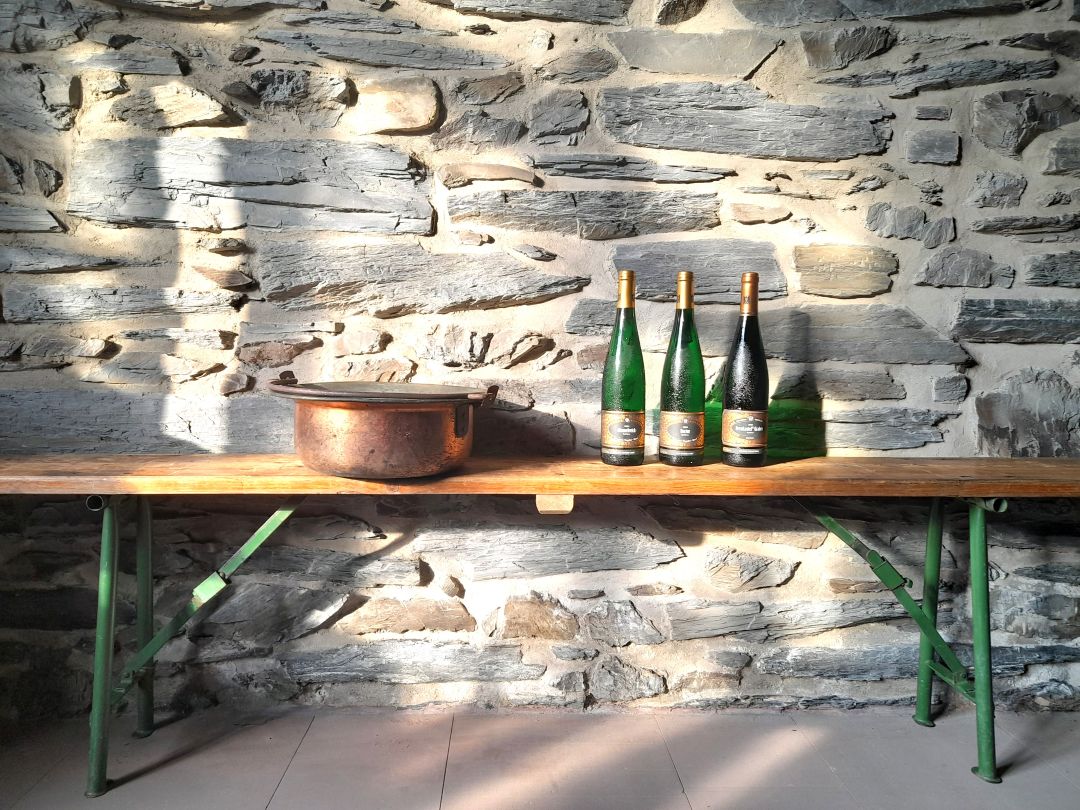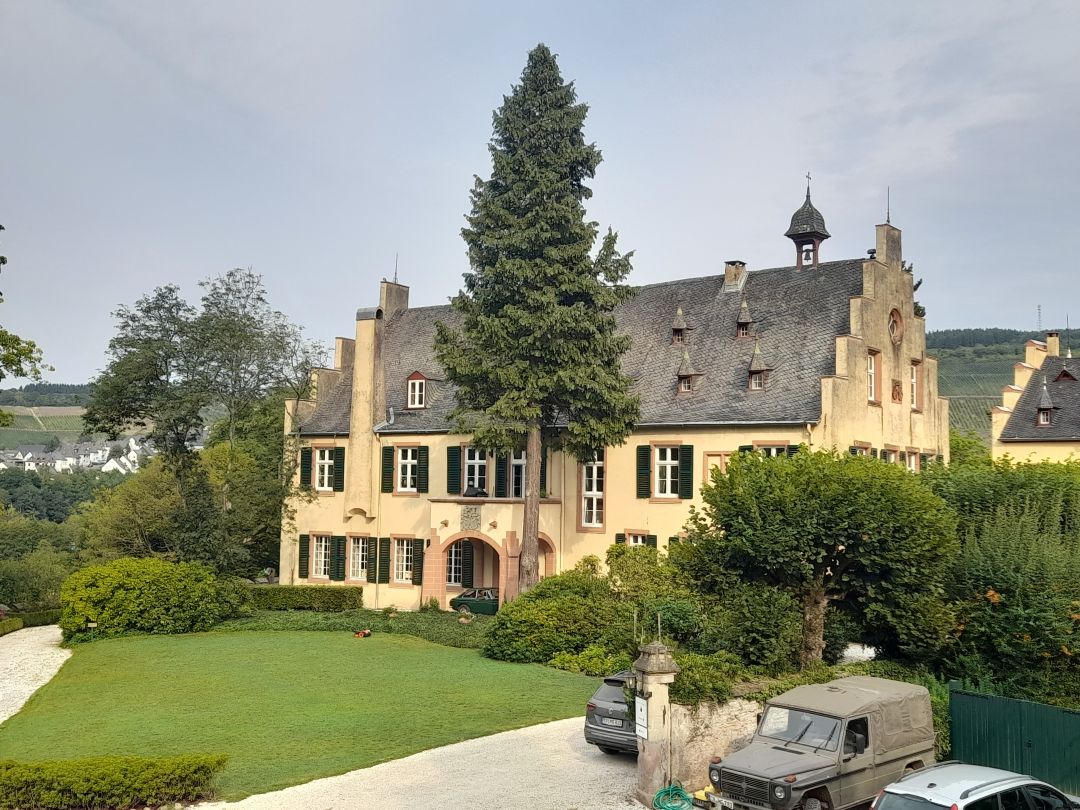Browse using the new Vinous website now. Launch →
Printed by, and for the sole use of . All rights reserved © 2015 Vinous Media
2024 Mosel, Saar and Ruwer: Tales of Woe and Wow
BY ANNE KREBIEHL MW | OCTOBER 16, 2025
Frost, hail, high water, a wet spring and dry periods in summer made 2024 a challenging year for wine growers in Mosel, Saar and Ruwer. Spring frost in April decimated yields, especially in Ruwer and Saar. Moselwein e.V., the local winegrowers’ association, reported that 2024 was “the smallest harvest in decades,” one-third lower than the long-term average. However, the results are sprightly, sleek, concentrated Rieslings with exquisite verve and full aromatic development.
Classicism
“It was the perfect Kabinett vintage,” was a sentence I heard time and again when speaking to producers about 2024. They said this with good reason, as the 2024 growing season united moderate—even low—alcohol levels and thus exquisite lightness with fully ripened acidity and high extract. These attributes are indeed ideal for making Kabinett and Spätlese styles. Two thousand twenty-four is the year in which these two Prädikate sing, down to a growing season that was longer and cooler than is now usual. Conditions later in autumn were not dry enough to warrant good botrytis, resulting in some Auslesen (some Goldkapsel), but few BAs or TBAs. Low yields in 2024 and the widespread absence of higher Prädikate, along with economic necessity, prompted a handful of producers to release some excellent library stock, held back for just such an eventuality by prudent estates and reviewed in this report.

The deep greens of late summer reflected in the Mosel at Wehlen.
Saar
A number of Saar growers remarked that rain hardly stopped all winter, beginning in October 2023 and carrying on incessantly through the season, which replenished dried-up reserves. The warm, moist spring meant an early budburst, but two cold April nights brought devastating frost. As a smaller body of water, the Saar River does not have the same moderating influence as the larger Mosel. Van Volxem reported fruit losses between 70% and 100%. Florian Lauer reported an 80% loss, while Max von Kunow at Von Hövel and Swen Klinger at Von Othegraven reported 70%. Sites in Wawern and Saarburg were less affected, but even Dorothee Zilliken of Forstmeister Geltz Zilliken reported 85% losses—including parts of the Saarburger Rausch site. My usual request for a tasting appointment at Egon Müller was not accommodated, “due to homeopathic amounts harvested in 2024.” Here are some examples of how little was harvested: Roman Niewodniczanski, owner of Van Volxem, said that his 14 hectares of vines in the Ockfener Geisberg yielded just 750 liters of GG and 4,000 liters of Kabinett. Max von Kunow noted that he had just 36 Fuders (rather than his usual 86) filled in the cellar. At Markus Molitor’s Domaine Serrig in the Saar, a site capable of filling 15,000 bottles yielded only 500 liters of wine (fewer than 700 bottles). Florian Lauer said that the only year where yields had been “similarly small” at the Lauer estate was 1900.
A lot of the existing wine reviewed here was from second shoots, which developed in some sites around four weeks after the frost. In effect, this created “two harvests,” as Von Kunow explained. Wet weather continued in the spring, and mid-May brought so much rain that some cellars flooded. Florian Lauer noted that only three vintages on record since 1881 were wetter than 2024, namely 1882, 1965 and 2000. The big difference was that 2024 was warmer than those similarly wet years. However, UV radiation after veraison was lower than in previous years. Lauer said, “From the first day of harvest to the last, there were just three degrees of Oechsle difference,” the equivalent of less than one-half percent of potential alcohol. The combination of low yields, sufficient moisture, fewer sunshine hours, and harvests not starting until late September and in some cases October, resulted in wines with fully developed aromas, excellently buffered and ripe acids and superbly svelte bodies. It is a balance of perfect ripeness without opulence, absolute stoniness without austerity. Kabinett and Spätlesen are especially stupendous and will be long-lived.

Anna Reimann of Weingut Cantzheim in Kanzem.
Ruwer
Far from any large bodies of water, the valleys of the Ruwer were hardest hit by the April frost. What Maximin von Schubert at Maximin Grünhaus referred to as the “zero hour” froze the entire Grünberg slope after what was the earliest budburst in the estate’s history. The only wines Von Schubert made were from secondary shoots. “We just carried on with everything. In the end, we could harvest around one-fifth of what we normally pick,” he said. That said the wines are excellent, especially his exquisite Kabinetts. Dominik Völk, viticulturist and manager at the Karthäuserhof, noted that they were only able to make two Kabinett wines across the entire slope from secondary shoots that were finally ready to be picked in late October. I will taste these in the coming year.
Mosel
With much moisture available from the wet winter, a warm March led to budburst later that month. When temperatures dropped dramatically in late April, shoots were already 10-15 centimeters long and totally vulnerable to frost. Thankfully, only cooler corners and lateral valleys were affected. Christopher Loewen, with sites in Thoernich, Longuich and Leiwen, reported 35% frost damage. Sites in lateral valleys, like the Dhroner Hofberg or the Wintricher Ohligsberg, were affected, as were sites in Osann, Monzel, Veldenz, Maring and Mülheim. Andreas Adam said that 1.5 of his 6.5 hectares froze in the lateral Dhron valley, while the Wehlener Klosterberg, where Molitor is based, was 90% frozen. Constantin Richter of Max Ferdinand Richter reported a 30% loss to frost. Most others either escaped the frost or sustained only marginal damage. Johannes Busch of Clemens Busch in Pünderich was spared in his main site, Marienburg, as was Matthias Knebel in the Terrassenmosel in Winningen.

A trio of triumphs at the Wegeler estate in Bernkastel.
May brought hail in Graach and Bernkastel, which reduced yields at Joh. Jos. Prüm and Willi Schaefer. That month also brought immense amounts of rain, a risk of flooding and some disease pressure, as well as instability during flowering. “During flowering, it was cooler and unstable, so flowering was extended,” said Christoph Schaefer at Weingut Willi Schaefer said. This led to extended ripening. He added, “At harvest, we picked the ripe grapes and left the others for another two weeks. In this respect, 2024 was a fascinating year. It is hard to explain, as we had a great sunny phase in August with lots of sunshine. We thought this would give us another push, but while the grapes ripened, sugars barely moved.” As a result, they made nothing above Spätlese. “It was not an easy year,” recalled Erni Loosen at Dr Loosen. “There was rain, dryness, and even though it was a warm vintage, ripeness was not a given.” Oliver Haag at Weingut Fritz Haag in Brauneberg noted that there were at least two harvest passes in every site, with the _Grosse Lagen_ being picked four times, each time only taking fruit that was at its peak.
The 2024 Rieslings are thus wonderful. There was no dry-stress, and alcohol levels are moderate throughout. Aromas are developed, and acids are buffered. Where 2023 bestrode the stage all jazz hands and bravado, 2024 is much shyer, but perhaps more interesting. What is striking about the Mosel Rieslings in 2024 is how much acids and extract swallow sweetness—20 grams per liter of residual sugar comes across like 10. These svelte wines come with immense sinuousness, exquisite lightness and much substance, a combination that is as compelling as it is unique. The Kabinetts are simply wonderful. The Spätlesen are dreamy. Any Prädikate above that are rare but beautifully pure.

Van Volxem cellar master Christoph Friedrich (left) and owner Roman Niewodniczanski delivered a brilliant collection in 2024.
More Woes
Though economic challenges are affecting the entire wine world, the situation is crystallized in the steep slopes of Mosel, Saar and Ruwer. The cost of growing grapes is just so much higher in this topography. Coupled with the increased cost of dry goods, energy and labor, yield losses from frost only exacerbate the issue. Bulk wine producers are the most negatively affected. On the one hand, this is the result of structural problems that have slumbered for years. On the other, even estates with prestige and established distribution channels feel the pain. One VDP winemaker reported a 27% reduction in sales last year that resulted in 70% less profit, also noting that this was not an isolated experience.
Anecdotal evidence underlines the problem. Dorothee Zilliken said that she had never before been offered so many sites for purchase within the Saarburger Rausch, while parcels within the Piesporter Goldtröpfchen are suddenly available for lease again. The frost losses of 2024 will merely accelerate what is already in the cards. Many smaller estates did not buy any fungicides to fight against oidium in 2024, as the expected yields would not have covered the outlay. Maximin von Schubert expects the landscape of Mosel, Saar and Ruwer to change dramatically over the coming three years, with many hectares of steep vineyards falling fallow. Christoph Friedrich at Van Volxem spoke of “the fastest structural adjustment we have ever experienced.” Erni Loosen took a more sanguine view, remembering all the various crises his forebears had endured. He does have a point, but that makes the current economic woes no easier to bear.

The historic villa at Maximin Grünhaus in the Ruwer Valley.
One way of addressing the expense of steep slope viticulture is increased mechanization. The local viticultural research station, DLG Bernkastel, has partnered with Van Volxem and received funding to develop a small, remote-controlled caterpillar tractor adapted to the specific needs of densely planted old vines on steep slopes. This is a welcome development, as a vineyard worker died earlier this year when his tractor overturned on a steep Saar slope. Viticulture is hard work across the globe, but here, it is back-breaking. The wines are still underpriced in terms of effort and cost of production. Considering their light-footedness, their deliciousness, their effortless ageability and above all uniqueness, they are the wine world’s most obvious bargains.
I tasted the wines in this report during estate visits in August 2025.
© 2025, Vinous. No portion of this article may be copied, shared or redistributed without prior consent from Vinous. Doing so is not only a violation of our copyright but also threatens the survival of independent wine criticism.
You Might Also Enjoy
2025 Germany Pre-Auctions Report: Trier & Bad Kreuznach -–Sleek, Svelte and Sensational, Anne Krebiehl MW, September 2025
Rheinhessen, Pfalz & Mittelrhein: A Game of Patience, Anne Krebiehl MW, September 2025
Rheingau and Nahe 2024: Rain, Frost and Unexpected Brilliance, Anne Krebiehl MW, September 2025
2023 Mosel-Saar-Ruwer: A Riesling Race Against Rain, Anne Krebiehl MW, December 2024
2022 Mosel-Saar-Ruwer: Old Vines and Steep Challenges, Anne Krebiehl MW, October 2023
2021 Mosel and Saar – Tantalizing, Tingling, Thrilling, Anne Krebiehl MW, June 2023
Show all the wines (sorted by score)
- A.J. Adam
- Alfred Merkelbach
- Axel Pauly
- Bruno
- Cantzheim
- Carl Loewen
- Clemens Busch
- Dr. Loosen
- Dr. Loosen - Zach. Bergweiler-Prüm Erben
- Fritz Haag
- Grans-Fassian
- Günther Steinmetz
- Heinrichshof
- Heymann-Löwenstein
- Joh. Jos. Prüm
- Julian Haart
- Karthäuserhof
- Knebel
- Loersch
- Markus Molitor
- Max Ferd. Richter
- Maximin Grünhaus - von Schubert
- Nik Weis
- Nik Weis St. Urbans-Hof
- Peter Lauer
- Schloss Lieser
- Selbach-Oster
- Twardowski
- Van Volxem
- von Hövel
- Von Othegraven
- Wegeler
- Willi Schaefer
- Witwe Thanisch
- Zilliken Forstmeister Geltz
